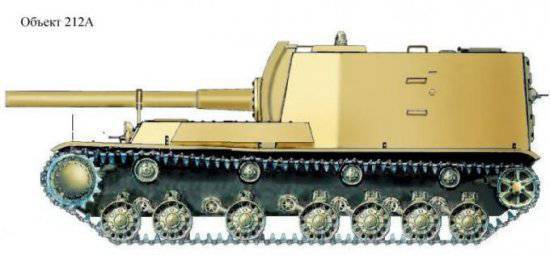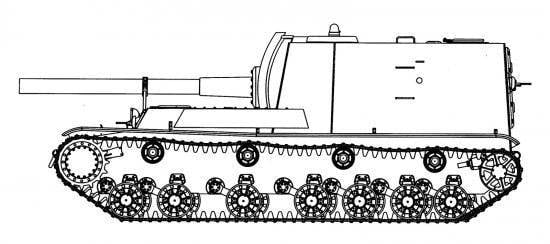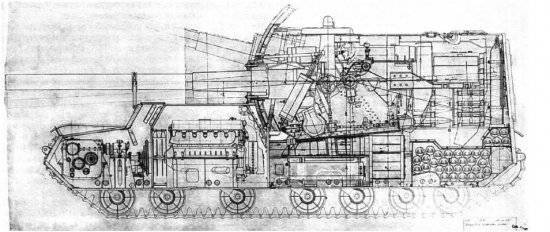SAU 212 Object
Shortly before the outbreak of war, the heavy chassis tank KV served as the basis for the development of self-propelled guns, which had an index of Object 212. The work was carried out in SKB-4 LKZ under the general supervision of J.Ya. Kotin, Ts.N. Golburt was appointed lead designer. The project, submitted to the ABTU at the end of 1940, was developed under the clear influence of the Soviet-Finnish war.
Overcoming the long-term fortifications of the “Mannerheim Line” proved to be much more difficult than it seemed to the General Staff of the Red Army, and it was simply impossible to solve it without the help of heavy artillery. In a number of cases, heavy cannon fired at Finnish bunkers with direct fire, which was not always possible in conditions of strong fire resistance. The problem could be solved by adopting the self-propelled guns equipped with large-caliber guns, but such machines were put to the test only at the beginning of February 1940, when the enemy’s defense was already broken. Since the urgent need for this kind of self-propelled guns disappeared projects T-100-Y and SU-14-1 preferred to close in favor of the tank breakthrough KV-2. Taking advantage of this, Kotin decided to independently develop the topic of heavy self-propelled guns, which could be used for strikes at the enemy’s immediate rear or at its leading edge of defense.
For the future self-propelled gun was selected gun Br-2 caliber 152,4-mm, previously installed on the SU-14 model 1937 of the year. This artillery system, created by the Barrikady design bureau in 1931, was initially rejected at comparative tests with the B-30 gun, but then, for reasons that were not quite clear, it was adopted. The choice in favor of the Br-2 was not the most optimal, since the gun had several design flaws, and its prototype was almost destroyed due to rupture of the barrel. However, during the 1937-1940 biennium, 37 guns were launched, which later became part of the heavy cannon regiment of the Reserve of the High Main Command.
Nevertheless, with all its shortcomings (low mobility, laboriousness in manufacturing, low barrel survivability) Br-2 had high power. The Br-2 ammunition nomenclature consisted of two types of ammunition: high-explosive fragmentation 53-OF-551 weighing 48,9 kg and concrete-breaking 53-G-551 weighing 49 kg. The initial velocity of the 53-OF-551 projectile was 880 m / s, the maximum range of the shot was 25 km (for small-rifled guns, this figure was 27 km). In the case of hitting any of these projectiles in a tank or armored vehicle, the result was their complete destruction. Structurally, the Br-2 gun consisted of a barrel (47,2 long caliber), piston-type shutter, gun carriage, hydraulic recoil brake and hydropneumatic knurler. The loading of the gun was a cap-type, but to facilitate the delivery of projectiles from the ground there was a special crane with a winch. In order to place this artillery system on the base of the KV, it was necessary to significantly modify the undercarriage. The number of track rollers was increased from 6 to 7, with the distance between them being reduced at the rear, and increased at the middle (less loaded). The supporting rollers remained 4, however, in view of the change in the layout, the drive wheel was moved forward. The guide wheel with a screw track tensioning mechanism is now located at the rear. The suspension of the self-propelled gun remained independent torsion bar. The self-propelled caterpillar was small-grained with a 660 track width mm. Changes to the chassis design were made due to a complete redesign of the layout. The fighting compartment was located behind and, in part, in the middle part of the body. The department of management in which there were places of the driver and the gunner-radio operator, was located between the transmission and engine compartment. The hull was welded and assembled from rolled 20, 30, 50 and 60 mm thick armor plates.
Gun Br-2 was installed in the wheelhouse and equipped with a telescopic sight. The pointing angles were quite modest and ranged from -3 to + 15 vertically and - \ + 8 horizontally. Despite the fact that the shells were now literally “at hand”, the actions of the loader were strongly limited to their mass. In order to facilitate the loading process, it was planned to install a special tray, like the M-10 howitzer in a KV-2 heavy tank. An armor-piercing projectile weighing 51,07 kg, which had an initial speed of 860 m / s, was introduced into the nomenclature of ammunition to the gun, and at the 5000 distance of meters could penetrate an 40-mm armor sheet.
For protection against infantry, SAU was equipped with three DT machine guns of caliber 7,62-mm. One of them was installed in the front hull sheet, the second - in the aft part of the combat compartment, the third was anti-aircraft and had to be mounted on the turret on the roof of the combat compartment.
Ammunition for the gun Br-2 was 47 shot separate loading and 3000 cartridges for machine guns DT. For comparison, the KV-2 tank was completed with 36 shots and 3087 cartridges.
Since the estimated mass of the 212A Object was close to 65 tons, it needed a heavy duty engine. As the main option, a forced B-2 with a centrifugal-driven supercharger was chosen, which was supposed to develop maximum horsepower 850. This would allow a maximum speed of up to 35 km / h and a range on the highway of the order of 200 km.
External communication was provided by the 71-TK-3М radio station with a whip antenna, internal communication (most likely) between crew members - an intercom system such as TPU-3 or TPU-3bis-F.
Although heavy self-propelled guns have lost their previous priority, the 212A Object project was approved by ABTU and was accepted for implementation. The construction of the SAU was to be carried out at the LKZ, where in December 1940 of the year a set of working drawings was sent for the manufacture of the hull. However, at this time, the company was heavily loaded with orders for the release of KV-1 and KV-2, for which the main forces of the Kirov design bureau were thrown. In addition, in April 1941, preparatory work began on the production of KV-3 tanks (the first version, with an elongated chassis and 76,2-mm cannon), so there was no longer any force left on the ACS.
The final assembly of the corps was delayed until June of the 1941 year, and after the start of the war, it was not up to an experienced “assault” self-propelled gun. Perhaps it would have been possible to bring the case to sea trials, but the LKZ did not manage to deliver the chassis for the SAU. As a result, self-propelled installation Object 212A was dismantled on the metal.
TACTICAL-TECHNICAL CHARACTERISTICS OF HEAVY SAU
Object 212A sample 1940 g.
Developer: KB LKZ
Started: 1940
Year of construction of the first prototype: 1941 (built only body)
The reason for the completion of the work: the beginning of the war and the unavailability of the prototype.
COMBAT WEIGHT - 63000 kg
CREW, people - 7
ARMAMENT
152,4-mm gun Br-2 and three 7,62-mm machine guns DT
BOECOMPLEKT
47 shots and 3000 ammo
HANGING APPLIANCES
telescopic sight
BOOKING
forehead felling - 60 mm
body shell - 60 mm
board - 50 mm
Roof - 30 mm
bottom - 20 mm
feed - 60 mm
ENGINE
В-2СН, diesel, 12-cylinder, 4-stroke, hp 850 power
TRANSMISSION
multidisk main and side friction clutches of dry friction, 5-speed gearbox
CHASSIS
(on one side) 7 dual main rollers, 4 supporting rollers, front drive and rear guide wheels
SPEED
30 km \ h
STOCK ON THE HIGHWAY
200 km
OVERCOME OBSTACLES
Wall height, m - 1,00
The width of the pit, m - 2,50
Wade depth, m - 1,30
MEANS OF COMMUNICATION
radio station 71-TK-3



Information